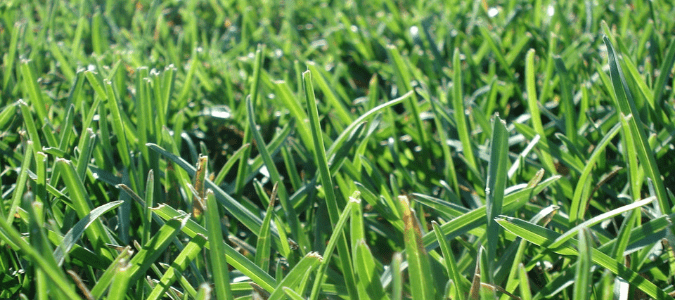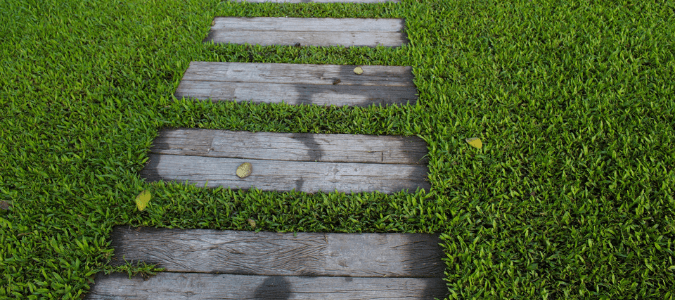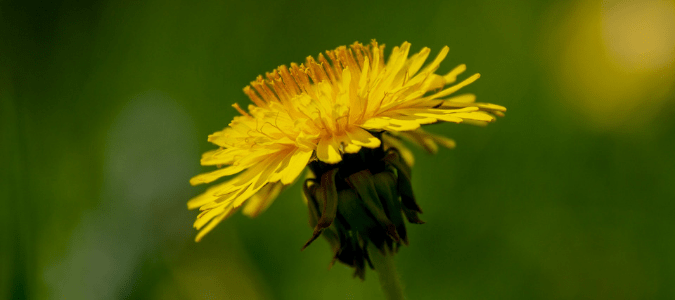
Due to its ability to withstand high temperatures and droughts, many homeowners choose St. Augustine grass for their yard. However, there are still quite a few St. Augustine grass problems that homeowners can find themselves confronted with. Fungi, chinch bugs and weeds are a few of the most common issues that can result in brown patches, uneven grass and dead spots that are unsightly and may require the assistance of a lawn professional to resolve.
Let’s examine each of these lawn conditions in a bit more depth.
Fungi
The main types of fungus that affect St. Augustine grass are:
- Take-all root rot (Gaeumannomyces graminis)
- Brown patch, also known as large patch (Rhizoctonia solani)
- Anthracnose (Colletotrichum graminicolais)
- Nigrospora stolon rot (Nigrospora sphaerica)
While drought and other factors can cause take-all root rot any time of the year, homeowners should look out for symptoms in the fall and spring months. The tops of the grass impacted by this fungus turn from green to yellow to brown, and the roots are black.
Brown patch is more likely to appear in the fall and early winter months, when nighttime temperatures drop below 70 degrees and daytime temperatures reach around 80 degrees. Blades with large patch are dark brown at the bottom and are easy to pull out of the roots.
An anthracnose lawn usually exhibits basal rot at the root of the stem. Patches of grass with this type of fungus are more yellow in color. These large patches tend to take on weird shapes and produce tiny, black spots on grass called acervuli.
Nigrospora stolon rot occurs, as you may expect, at the stolon of the plant, which is the stem near the soil surface. When St. Augustine grass suffers from this type of fungus, the movement of water and nutrients is unable to get to the roots of the grass, making its leaves turn yellow and die. Many homeowners will confuse this rot with take-all root rot because of the yellow coloring of the leaves. However, if you look closely, you will see that the roots will not turn dark brown or black in color.
Some of these conditions can occur concurrently, so it may take a professional’s eye to properly diagnose which type of fungus is impacting your grass.
Chinch Bugs
St. Augustine grass doesn’t attract a whole lot of pests, but homeowners should be on the lookout for chinch bugs. These hard-to-spot pests don’t just feed on your grass—they actually remove the fluids from the plant and inject it with a toxin. It is this toxin that makes your grass wither and turn yellow or reddish-brown, then die.
You will know you have chinch bugs and not an irrigation problem if additional watering doesn’t brighten up these dead spots.
If you’re trying to scope them out, these pests will always be in the sunniest parts of your lawn. Because these bugs love the heat, they are most active starting in June until late August. You’re not looking for just a few bugs, either. Typically, if you’ve got a problem, there are about twenty to twenty-five of these creatures per square foot.
Weeds
St. Augustine is a tough grass and less vulnerable to weeds than some other varieties. Still, some pesky weeds may pop up in your grass if you fail to fertilize or water properly throughout the year. There’s only a finite amount of water, sunlight and nutrients in the ground and weeds will compete with your St. Augustine grass for these resources and take away from the aesthetic appeal of your lawn.
If you are victim to these and other problems in your St. Augustine lawn, you should know that getting your lawn back to its optimal condition can be a difficult task. Now, we’ll go into more detail about how to combat these lawn problems.

Treating St. Augustine Grass Fungus
When treating your lawn for fungus, avoid using nitrogen fertilizer, as it encourages fast growth. What you might not realize is that encouraging your St. Augustine grass to grow can actually make your lawn more susceptible to fungus.
Many homeowners will turn to fungicides to address lawn issues. However, if you apply a product that is not specially formulated for St. Augustine grass, you may inadvertently cause other problems.
If you’re wondering when to apply fungicide on your lawn, the answer is as soon as possible. The more the fungus grows, the harder it will be to eradicate.
When applying fungicide, be sure to follow the manufacturer’s instructions. Keep in mind that fungicide does contain chemicals, so be extremely cautious during application. Wear eye protection, heavy gloves, pants, a long-sleeved shirt, socks and closed-toed shoes to protect yourself. Most of the time, hiring a professional to apply fungicide for you can be the easiest option.
Preventing Fungus
Proper lawn care is the best way to prevent all types of fungi, as the less stress your grass is under, the healthier it will be.
Most fungi are caused by excessive moisture, so water deeply and infrequently, and make sure you have proper drainage throughout your lawn.
You should apply your first fertilizer application after the lawn has been mowed a couple of times in the spring. Then, you may consider reapplying in the summer and fall if your grass receives full sun exposure. If you’re unsure how much to fertilize or when to fertilize, a lawn care specialist can evaluate your lawn and give you more customized recommendations.

St. Augustine Chinch Bugs: Treatment and Prevention
Before you start to treat your grass for fungus or other problems, make sure that chinch bugs haven’t gotten to your yard.
These pests are not easy to spot, as they are only about a fifth of an inch long, but you can use dishwashing detergent to get them moving. Mix two tablespoons of detergent with a gallon of water, a concentration that will not impact the health of your plants. Use a watering can to pour the liquid over a three-foot by three-foot patch of your yard, and take a close look for bugs, as the mixture invades their space and sends them scrambling. The adult chinch bugs will have black bodies with white wings and brown legs, while young chinch bugs are bright orange in color. Most chinch bugs will have a white band across their body that makes them easier to identify.
An infestation of chinch bugs can look like drought damage, so one way to test a particular spot on your grass is by getting a coffee can and removing the top and bottom and pushing the can into your grass around the impacted location. Add water to the can, wait around 10 minutes and see if any bugs float the the top of the water. If no bugs appear, it may be stress from hot and dry conditions.
Chinch bug damage and take-all root rot can easily also get mistaken for each other, so be sure to know the differences between these problems and how to address them before you start chinch bug treatment.
Treating Chinch Bugs
The most effective way to treat chinch bugs is through an application of insecticide, but make sure to remove thatch and overgrown areas of your lawn beforehand to properly expose the chinch bugs to the treatment. If you don’t feel comfortable applying insecticide to your lawn, we recommend calling in a professional who can effectively and efficiently treat your pest problem.
Remember that if you’re buying liquid insecticide, you will also need to buy a spraying machine to apply the treatment. Make sure you follow all of the directions on the label to ensure you’re eradicating all of your chinch bugs, but also to ensure you don’t do anything to put you, your family or your lawn’s health in danger.
Don’t delay treatment if you know chinch bugs are on your lawn. On average, these pests can lay 300 eggs in their lifetime.
Preventing Chinch Bugs
Unfortunately, simply having a lawn puts you at risk for having chinch bugs. However, by keeping your lawn clear of excess debris such as leaves, heavy thatch and large amounts of grass clippings, you can make your lawn less attractive for these destructive pests. As we have already mentioned, having a proper lawn care maintenance schedule in place also helps to prevent a chinch bug infestation. The more healthy your turf, the more likely your St. Augustine grass will be able to withstand a chinch bug infestation.

How To Treat, Prevent And Identify Weeds In St. Augustine Grass
Since each type of weed may require a slightly different approach to eliminate, you’ll want to determine exactly which variety is on your lawn before you begin your control efforts. Some of the most common weeds you’ll find in St. Augustine grass include:
- Dandelions: These weeds are easy to spot, since their bright yellow flowers make them stand out against your green grass. Dandelion petals are long and slim, and additional green leaves sprout near the base. You’ve likely seen these weeds before and maybe even thought they were pretty—until they appeared on your lawn.
- Goosegrass or silver crabgrass: This grass—with its long, thick leaves that can reach up to a foot long—is often confused with crabgrass. You can determine the difference between the two because goosegrass will be a white or silver color near the root.
- Crabgrass: Crabgrass has long, thick leaves that grow outward from shallow roots in a star-shaped pattern.
- White clover: While some homeowners enjoy having white clover in planted flower boxes, this plant can easily overtake your lawn. The flower of this weed will be pink in the center with white crescent-shaped petals.
- Dollarweed: Also known as pennywort, this weed gets its name because its leaves are the shape of a silver dollar. Dollarweed growing in your lawn is often a sign that you’re watering too much, as these weeds thrive in wet environments.
Treating Weeds
If it’s early in the year, pulling out weeds will help to eliminate them right off the bat and prevent their spread from ruining your lawn’s appearance throughout the summer. During this time, remember to bag up your lawn clippings to prevent the weeds from going right back into your lawn.
If you opt for herbicide, make sure you know how the specific product you have purchased works. Too much herbicide, or a mixture that is too concentrated, can do more harm than good and actually kill the healthy parts of your lawn.
If you are using a postemergence herbicide, start by applying half of what the instructions recommend initially and then apply more as needed. Also, double check that your product is suitable for St. Augustine grass, as some formulations created for other grass types may actually cause problems when applied to other varieties. Make sure to wait at least a week after your last mowing to apply your herbicide, as this allows the lawn to “heal” and prevent your grass from absorbing the herbicide and sustaining damage.
Preventing Weeds
Weed prevention starts with laying down your grass in thick blocks of sod or plugs. The thicker your lawn, the less room weeds will have to sneak in and take root.
Don’t use weed killer if your lawn is in its first year of growth. Simply pick weeds and bag lawn clippings every time you mow. Proper maintenance, no matter what the “age” of your grass, can also encourage thick lawn growth. All in all, creating an annual lawn care schedule will help keep your grass resilient, thereby lowering your chances of weed growth.

How To Revive St. Augustine Grass
After applying needed treatments to your yard and eradicating your St. Augustine grass problem entirely, it’s time to get your grass growing again. By cutting your grass at higher lengths and only cutting it once every ten days, you can make your grass stronger. This practice helps the healthy grass protect the grass that has been damaged, allowing it time to grow and become healthy. When mowing the healthy parts of your lawn, leave your grass clippings instead of bagging them, so that you can bring nutrients back into the soil. Also, to reduce stress on your grass during your restoration efforts, restrict use or even stay off it entirely.
As we’ve already mentioned, the single most important thing you can do, whether your grass is healthy or showing signs of a problem, is to create a lawn care maintenance schedule. You shouldn’t just be concerned about how to keep your lawn green in summer heat—these fungi, weeds and bugs all have different seasons where they are most active so your lawn care should take these seasonal considerations into account.
ABC Can Help Treat And Prevent Lawn Problems
Coming up with a specialized maintenance schedule for your lawn can be a challenge for many homeowners, since every lawn will have slightly different requirements. The professionals at ABC Home & Commercial Services have the experience and knowledge to troubleshoot common lawn problems on any type of lawn and implement a treatment plan that will keep your lawn beautiful and green all year long. Our lawn experts can handle everything from regular mowing to chinch bug control to fertilizing. With ABC’s help, your lawn will be one less thing you have to worry about.